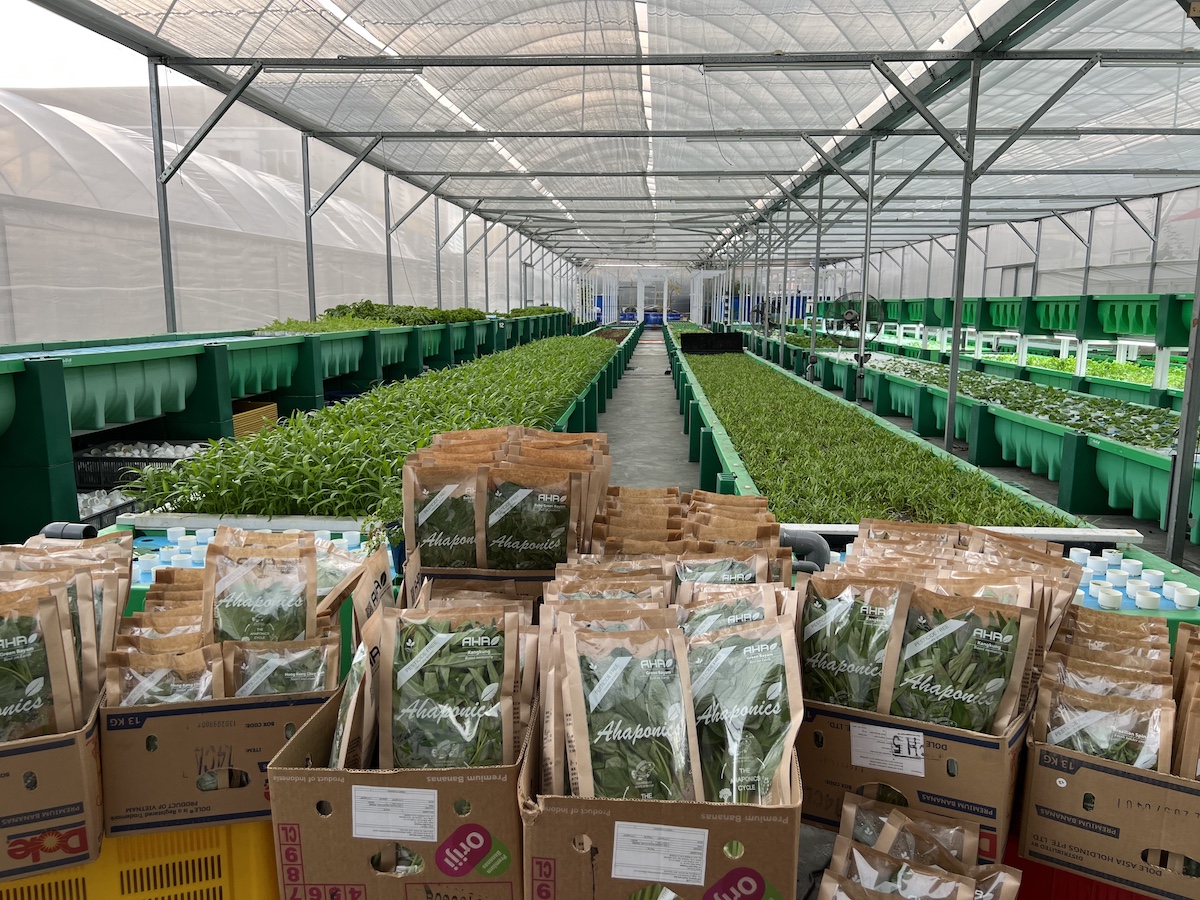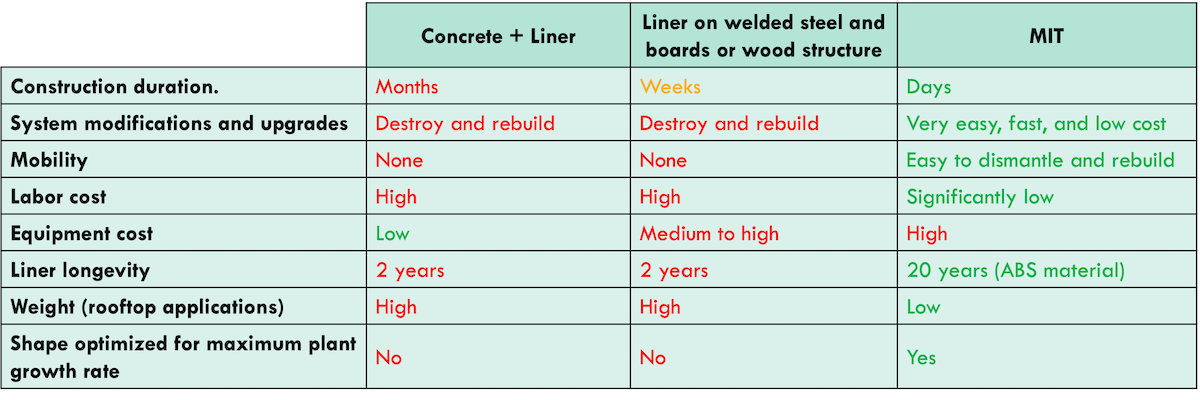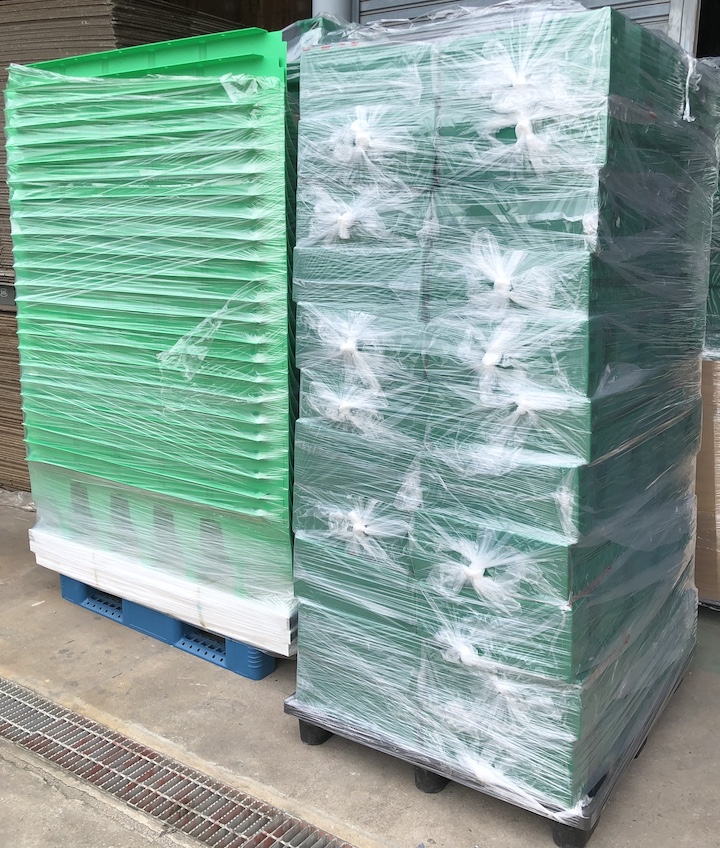Commercial Systems
AHAS proprietary design based on 10 years of experience
AHAS Malaysia

The freshly harvested products are distributed in local supermarkets.
Singapore Hotel Farm
The first Urban Aquaponics farm built in a Hotel in Singapore has made the news several times. It also received the congratulations of Dr Amy Khor, Singapore's Minister of State for environment and water resources.
Urban Aquaponics Center
This large farm factory not only sells healthy and tasty aquaponics crops but also serves them in a healthy products shop, a restaurant, and an enjoyable bar. It also hosts an aquaponics training center and a manufacturing area where aquaponics products like fish food and fertilizers are made.
The hospitality industry
Aquaponics is the healthy and tasty food manufacturing process of the future. Any hospitality business embarking on such an innovative facility within the complex will enjoy a tremendous differentiation from its competitors. Such a facility is part of the Eco journey to sustainability that all newly built hospitality projects should envision.
Better than a certification of organic process compliance, the aquaponics process itself guarantees the quality and safety of the product, as no harmful chemical can physically be used without destroying the ecosystem. Aquaponics is a natural process. Aquaponics produces superior quality vegetables than organic farming. And fish protein in addition. Almost all vegetables can be grown Aquaponically.
No transportation and no plastic entering the building, drastically reducing carbon emissions. It is the right thing to do, as far as sustainability is concerned.
The wonderful aspect of such a Farm-to-Table project is the freshness of the fish and vegetables harvested minutes before they are served to the guests, who get to enjoy a phenomenal product.
If you envision differentiating your hotel from your competitors, aquaponics is the way to go.
The Aquaponics system also offers great support to promoting aquaponics in your area. The hotel will be the aquaponics reference in the country and be the best place to host sustainability seminars.
AHAS was a pioneer in developing commercial aquaponics in 2015. When pioneers meet pioneers, we get these outcomes:
The General Manager feedback
Marcus Hanna, General Manager of the Fairmont Swissotel in Singapore, is thrilled by the AHAS Aquaponics Farm and explains the value of such a project for the Hotels in relation to other sustainability-related projects. Chef Robert Stirrup is proud to offer a tremendous product to his Guests.
The Chefs comment
Chef André Kaiser enjoys serving the Hotel Guests incredibly tasteful dishes made of “better than organic” products harvested just minutes before being served.
Why using MIT to build your Aquaponics system?
It took four people over four months to build our 900m2 unit in Thailand using a steel frame, fiberboards, and soft liner DWC. In addition, we had to junk all equipment three years later, as we started to face major leaking issues.
It took three workers ten days to build the same size unit using the MIT.

Is labor cost high in your country?
How much does 4 months of labor cost?
Do you want to start producing just a few days after starting construction?
Do you want to be able to reconfigure your system easily at will?
Are you renting the area? Is there a risk you would have to relocate your farm?
Is there a weight limitation of the building structure hosting the unit?
Are you looking for a system optimized for maximum growth rate?
We assist you with your design
We offer commercial aquaponics design based on your production objectives and available space. Every design is unique.
We build all units with equipment that dod not require any modification to the building and can be upgraded easily. This equipment are rapidly and efficiently installed. We provide technical assistance in designing, building, and starting up farms. We teach and coach the operating teams. We provide 24x7 technical support and personalized services to all our clients.
All our designs and related production rates are made using our proprietary modeling software, Ceres, that is continously updated with actual production data from all our units for each crop. As long as the production techniques are followed, you will get the same production.
AHAS Project design process
We handle all commercial farm design projects as follows:
- Collect client objectives:
- Crops and production targets
- Area available
- Special design consideration
- Complete a draft design
- Check the area’s suitability (land slope and strength, sunlight, access to water and power)
- Dimension the plant area to match the production target
- Dimension the fish engine for perfect aquaponics balance
- Design and dimension the hydraulics, energy requirements, and solar system)
- Dimension the utility area (seeding, cleaning, packing, storage, sales, …)
- Optimize the layout for practical and efficient workflow
- Review with the project owner
- Finalize the design
- Complete final drawings
- Provide floor layout for piping through and drainage
- Evaluate the final project production, cost, operating cost, expected ROI
- Compile a detailed report on the project
- Manufacture and ship equipment (50% down payment at order, balance before shipping). Manufacturing takes usually takes 8 to 10 weeks from order.
- Supervise installation client team
- Start the unit and train the client operating team to aquaponics and unit operations and maintenance requirements (Course AHAS-TC01 and AHAS-TC02)
- Coach on site as necessary
- Provide 24/7 remote support
AHAS Deliverables
AHAS’ deliverables include:
- Design, engineer, and procure equipment to build suitable aquaponics units on a prepared ground, as per Destinations Development Company (DDC) requirements.
- Installation supervision, system commissioning, and aquaponics unit start-up.
- Provision of AHAponics process and unit operations training
- Provision of long-term technical and operational support as required.
AHAS engineering team always works with the Customer’s engineering team to finalize the optimum design to fulfill the project’s objectives.
- Concept Design Validation
- Schematic Design
- Detailed Design Construction
- Documents Construction
- Administration
AHAS standards
We manufactures equipment as per top quality standards. We also advise our customers who are building their own MIT unit to use equipment tested that passes our standards:
- For longevity and UV resistance, all pipe and fittings must be high-pressure minimum Grade D or equivalent (i.e. type 8.5 or 13.5).
- All water pumps are highly efficient and have low energy consumption.
- For safety, all equipment submerged in the water uses a maximum of 24V power voltage.
- Our design deliverables include a detailed floor map with the location of all required troughs for piping and power points.
All our designs are completed on 3D software at scale.
Feasibility study
The area is to be built to receive the proposed design.
The main requirements are:
- Flat, perfectly leveled, and cemented area suitable to hold the unit weight.
- Through prepared in the floor to host the piping
- A climate control system is required to maintain the greenhouses at a temperature between 15 and 25 degC, and the water at 20 to 24 degC.
Structural load and area preparation
The following load will apply to the building structure
- Each MIT full of water weighs 500kg (1000kg for MIT-Duo), distributed on each leg of 20cm x 120cm every 1.5m. We usually spread the lines at 80cm, so the average spread load for each MIT is 167kg/m2 for single-layer MIT, 334kg/m2 for MIT-Duo, and 500kg/m2 for MITtrio.
- Each fish tank holds up to 3500 liters of water, 80 to 110cm high. The spot load is 780kg/m2, and the spread load over 10 m2 is 350kg/m2.
- The filtration system is made of:
- Coarse filtration tank of 1200 liters, 90cm high. The spot load is 900kg/m2, and the spread load over 4 m2 is 300kg/m2.
- Fine filtration tank of 2000 liters, 90cm high. The spot load is 900kg/m2, and the spread load over 6 m2 is 330kg/m2.
- Biotreatment unit 2000 liters, 80cm high. The spot load is 950kg/m2, and the spread load over 6m2 is 350kg/m2.
The area must be flat, perfectly leveled, and cemented. To support the load, a cemented floor is the best recommended option. AHAS provides a floor map with the location of all throughs required to fit the piping in the floor. These through should be prepared before cementing the ground.
By providing a Purchase Order, it is understood that the weight load plan is acceptable and compatible with the building structure. AHAS is not engaged in structural engineering and therefore, assumes no responsibilities nor liabilities related to the ability of the building to support the unit weight as well as the environmental conditions in the area.
Area Access and equipment delivery
All equipment is shipped from AHAS Warehouse on pallets in trucks or containers. The access from the road to the greenhouse must be confirmed.
The most economical transportation from AHAS warehouses is in 40-foot or 20-foot containers or trucks. Since all items are delivered on pallets, these pallets can easily be transferred to smaller trucks for local transportation.
Equipment can be shipped from AHAS warehouses in China and Thailand.

Power requirement
The power requirement is provided in the technical description of each unit and may include:
- Water pumps, 220V, operated continuously.
- Air pumps for fish engines, 220V, operated continuously on a UPS system.
- Air blowers for MIT grow beds, 220 single-phase or 380V 3-phase, operated continuously.
- Biosystem pumps, 220V, operated by timers.
- Grow lights, 220V, operated 12 to 18 hours/day.
Productivity
The AHAS proprietary Aquaponics Modeling software compute productivity for various plants. Ceres is continously updated with actual production data from all our units for each crop. As long as the environment is coptimum and AHAS production techniques are followed, you will get the predicted production.
